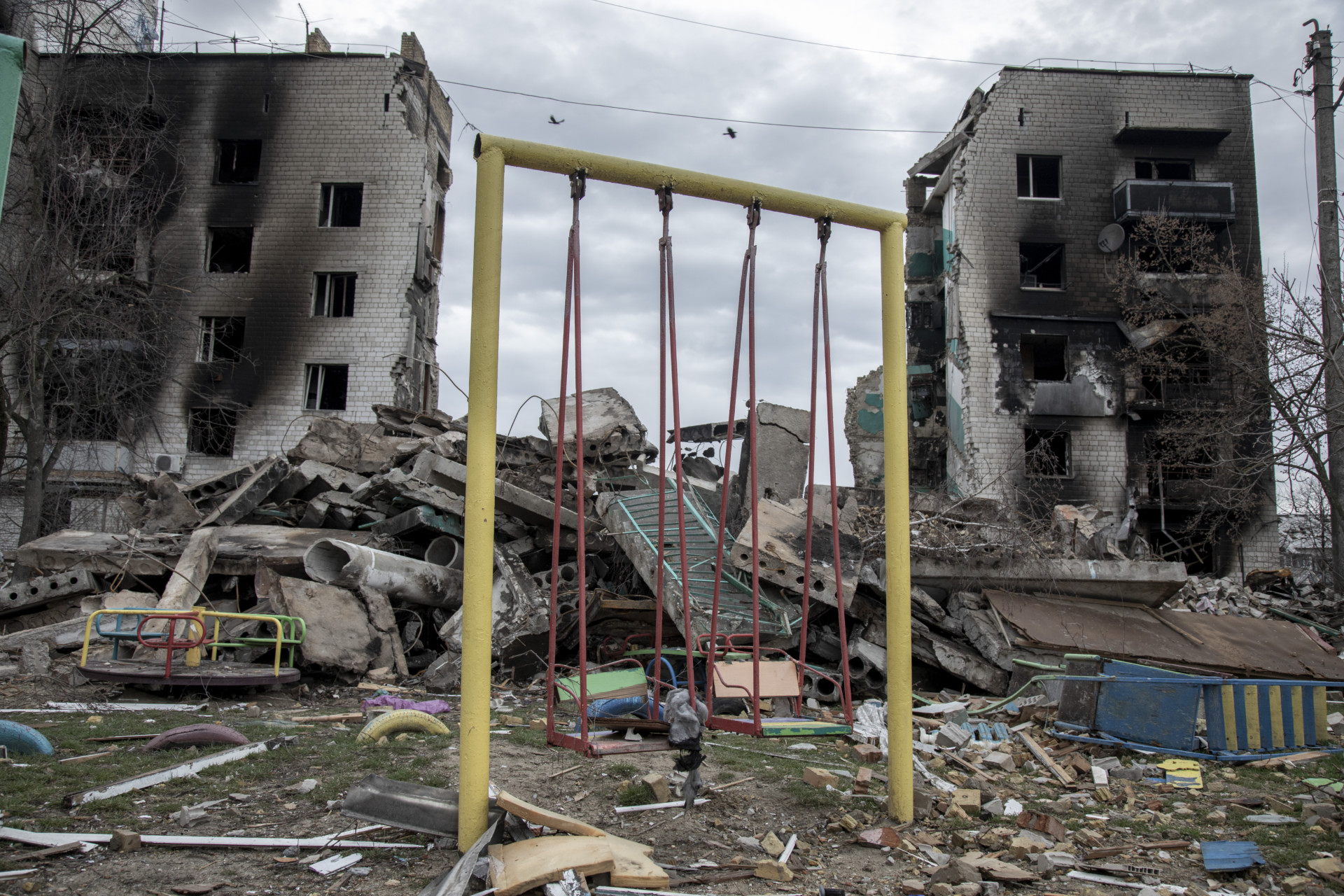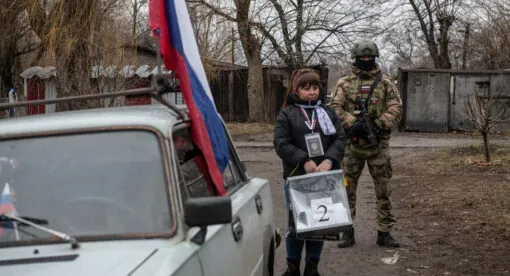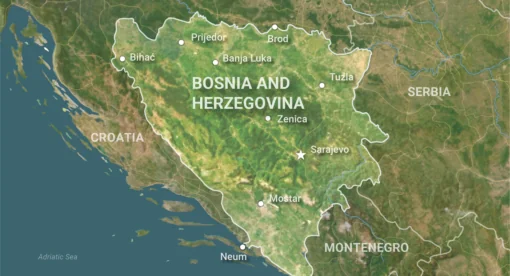Urbicide is a distinct form of mass violence characterized by the deliberate destruction of vital civilian infrastructure. In total disregard for international humanitarian law, urbicide is undergirded by a logic of collective punishment, targeting civilian populations and the built infrastructure on which their lives depend. Taken to their furthest extent, such campaigns of systematic bombardment and destruction can leave entire cities in ruins, hence the term urbicide – the “killing” of a city.
From the onset of Russian President Vladimir Putin’s invasion of Ukraine, Russia has engaged in a sustained and systematic campaign of urbicide. Both targeted and indiscriminate attacks by air, land, and sea continue to destroy vital civilian infrastructure, systematically denying Ukrainians access to basic needs and essential services. As of May 25, Russia has fired more than 2,150 long-range, precision-guided missiles into Ukraine, many targeting critical national infrastructure hundreds of miles from any active front line, including in the country’s far west.
Russia’s campaign of urbicide has been most intense in Ukraine’s south and east, particularly since the Kremlin’s retreat from around Kyiv and the north. Commenting on the ever-increasing destruction in the Donbas, Ukrainian President Volodymyr Zelenskyy has labeled Russia’s attacks as “a deliberate and criminal attempt to kill as many Ukrainians as possible.” In hundreds of towns and villages along the lines of contact, and in cities like Severodonetsk and Kramatorsk, swaths of civilian infrastructure have been damaged or destroyed. Mariupol, the city most devastated by Russian attacks, has been all but leveled by months of sustained and indiscriminate bombardment. It stands as a stark warning of the extent to which the Kremlin’s strategists are willing to pursue the deliberate destruction of civilian infrastructure.
Russia’s onslaught in Ukraine has resulted in tens of thousands of civilian casualties and has triggered a refugee crisis. More than 12 million Ukrainians have fled their homes since Feb. 24. As of May 19, The U.N. Office for the Coordination of Humanitarian Affairs reported 15.7 million Ukrainians in need of assistance and protection. Despite unprecedented global support, humanitarian needs in Ukraine and the region risk outpacing the current international response.
With a long and increasingly entrenched war likely, urbicide will continue to define Russian tactics in Ukraine. The evidence suggests that in the Donbas region and the south, Russian forces are systematically destroying infrastructure to take and hold territory. The Russian military will continue to reject the principles of distinction, proportionality, and necessity, aiming to cripple Ukraine’s critical national infrastructure and to weaponize chaos, destruction, and civilian harm.
Russia’s urbicide in Ukraine demands an immediate and focused policy response. Systematic attacks on civilian infrastructure raise complex and urgent challenges for the international community, issues relating to civilian protection, humanitarian aid, forced displacement, justice and accountability, and the breakdown of international humanitarian norms. The U.S. has led global efforts to support Ukraine, but maintaining long-term political will and momentum will be crucial. In relation to urbicide and the urgent need to protect Ukraine’s civilians, policy makers must continue to prioritize:
- Lethal aid: ensuring Ukraine can defend its population centers and vital national infrastructure
- Humanitarian aid and access: building a collective and sustainable response to the humanitarian crisis in Ukraine and the region
- Justice and accountability: supporting efforts to gather evidence of war crimes and crimes against humanity and committing to the eventual prosecution of perpetrators
- Global efforts to restrict the use of explosive weapons in populated areas
Russian President Vladimir Putin’s invasion of Ukraine aimed to catalyze regime change and crush the country’s burgeoning democracy. Moscow’s strategists planned for the swift capture of Kyiv, hoping to drag Ukraine and its population from the EU, NATO, and the West. This has long been Putin’s ambition, at least since the 2014 ouster of Kremlin-backed President Viktor Yanukovych. The invasion of Ukraine reflects Putin’s deep-seated and ever-increasing paranoia, his fear that popular revolution and democracy in neighboring countries will threaten his own grip on power.
The Kremlin’s hopes for a “lightning war” were quickly dashed, Russia’s initial assault on Kyiv an unmitigated failure, bogged down in the face of operational and logistical shortcomings, and repelled by determined Ukrainian resistance. In the months since, Russian tactics in Ukraine have been defined by deliberate and sustained attacks on civilians and civilian infrastructure. Russia’s onslaught constitutes urbicide, the systematic destruction of civilian infrastructure and the built environment upon which modern life depends. Urbicide is a distinct form of mass violence, a concept first popularized within holocaust and genocide studies in the aftermath of the urban devastation witnessed during the Balkan Wars of the 1990s.
Most often characterized by sustained bombardment and strict blockade, urbicide has consistently been employed by authoritarian states as an effective coercive institution. As in Ukraine, the systematic destruction of civilian infrastructure has long been employed to safeguard power, crushing threats (imagined or otherwise) and advancing domestic or geopolitical interests.
Russian Urbicide in Ukraine: Systematic Attacks on Critical Infrastructure
In Ukraine, Putin’s forces have systematically targeted populated settlements and critical national infrastructure. Strategically, urbicide serves a number of purposes in Russia’s war effort. In the Donbas and the south, Russia destroys civilian infrastructure, and even entire settlements, to take and then hold territory. In addition to this, long-range attacks on sites of critical civilian infrastructure throughout the country, including in the far west, spread disruption, chaos, and fear far from the front lines. With these attacks, Russia aims to leave civilians struggling with the impossibility of life without water, food, fuel, electricity, fuel, sanitation, medical care, mobility, and shelter.
The most obvious evidence of Russia’s urbicidal campaign in Ukraine is the extraordinary number of Ukrainians that have been forced to leave their homes since Feb. 24. More than 7 million Ukrainians are internally displaced, and a further 4 million have been forced to flee the country.
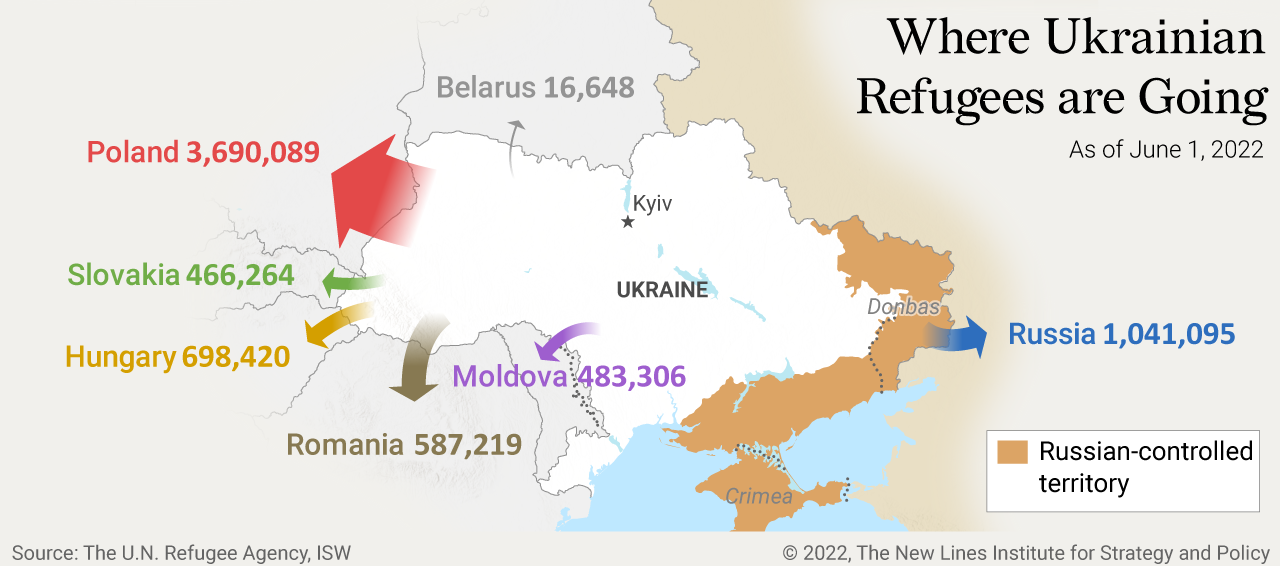
Long-range attacks mean that despite much of the fighting being focused in the east, many displaced Ukrainians rightly feel that it is unsafe to return. Since Feb. 24, Russia has launched more than 2,150 long-range missiles into Ukraine, many destroying civilian targets far from active front lines or military targets, including in the far west of the country.
With the war in Ukraine now into its fourth month, clear and damning patterns have emerged in Russia’s attacks on Ukraine’s critical civilian infrastructure. Most notably, repeated and targeted strikes on Ukraine’s health, energy, and transport sectors speak to the deliberate doctrine of civilian harm that undergirds Russia’s urbicide in the country. These attacks have, as intended, denied millions of Ukrainians their right to basic necessities and essential services.
Health Care Facilities
Throughout Ukraine, health care facilities have been damaged or destroyed by both indiscriminate and targeted Russian attacks. In Kharkiv, for example, Airwars documented a cluster munitions attack on a children’s hospital and blood donation center. This was just one of more than 243 attacks recorded by the WHO in Ukraine between Feb. 24 and May 23. This figure is proof of a systematic attempt to destroy Ukraine’s health care sector, part of Russia’s broader campaign of urbicide in the country.
The impact of these attacks, combined with strict blockade in many front-line areas, has been devastating. The country’s most vulnerable people – children, the elderly, those with chronic health conditions, and the disabled – suffer most. As many as one in three Ukrainian households are without access to medical facilities, a figure that is likely far higher in the south and east, where reports suggest that virtually no hospital or health facility remains undamaged.
Energy Sector
Ukraine’s Ministry of Energy has said that Russia is doing everything possible to maximize damage to Ukraine’s energy sector, and evidence supports this claim. Deliberate attacks on power plants, vital components of the water, gas, and electricity grids, and repeated strikes on oil and fuel infrastructure have increased since the Kremlin’s decisive shift to the eastern theater. On April 3, separate long-range missile attacks struck at the heart of Ukraine’s oil industry – one damaging the country’s largest and only remaining oil refinery at Kremenchuk, the other hitting critical oil processing infrastructure near the southern port city of Odesa. Since then, Kremenchuk and a nearby thermal plant, have been repeatedly targeted, most recently by 12 long-range missiles on May 12. These repeated attacks on Ukraine’s domestic oil sector have left the country entirely reliant on foreign oil imports from railways in the west. In cities throughout Ukraine, like Lviv, Dnipro, and Kyiv, civilians are forced to queue for fuel due to acute shortages.
Though Ukrainian engineers have, where possible, managed to repair damage to the country’s energy sector, Russia’s urbicidal tactics have nonetheless left vast numbers of Ukrainians without electricity, fuel, water, or sanitation. As of May 19, more than 640,000 people, across 696 settlements, are without electricity. A further are 200,000 without gas, the result of damage to at least 47 gas distribution stations. The situation with regard to water is equally as critical, with UNICEF reporting that damage to critical infrastructure has left 1.4 million Ukrainians without access to clean water or sanitation and 4.6 million with only limited access.
The impact of these calculated attacks is most severe in the south and east, where intense fighting continues and repairs remain impossible. Large cities – Mariupol, Kharkiv, Mykolaiv, Izium, Donetsk, Luhansk, and Severodonetsk – have been left without electricity, fuel, or water for months.
Railway Infrastructure
Russian strategists have increasingly targeted the country’ railway network, deliberately damaging railway stock, signals, stations, and electricity substations. On April 25 alone, five railway stations in central and western Ukraine were struck in a single morning. Local officials report that the damage will take months to repair. And on May 17, Russian cruise missiles struck railway infrastructure in Lviv. Most recently, on June 5, four Russian missiles launched from long-range bombers over the Caspian Sea targeted railway repair facilities in Kyiv, the first attack on the capital in over a month. As of May 19, the Kyiv School of Economics (KSE) estimates more than $3.5 billion in damage to Ukraine’s railways since Feb. 24.
The Kremlin claims that these attacks are intended to slow the pace of military aid to Ukraine. However, the systematic targeting of railways has a deliberate impact on the country’s desperate civilian population, hindering evacuation efforts to the west and making the delivery of humanitarian aid more difficult. The pernicious intent in Russia’s attacks on Ukraine’s railways was clearly demonstrated on April 8 when two Russian Tochka-U missiles, scattering internationally prohibited cluster munitions, targeted Kramatorsk station. The platforms were crowded with thousands awaiting evacuation. At least 57 civilians, including nine children, were killed.
Attacks on the medical, energy, and transport sector represent only a fraction of the damage inflicted on Ukraine’s critical civilian infrastructure and population centers. Across hundreds of settlements, particularly in the south and east, schools, hospitals, malls, factories, churches, administrative buildings, and other civilian infrastructure have been damaged or destroyed. Efforts made by the KSE to assess infrastructural damage provide grim insight into the massive scale of Russia’s urbicide in the country. As of May 19, KSE report a minimum of $97.4 billion in direct damage to Ukraine’s infrastructure, stressing that these figures represent a low-end estimation and that the true figure is likely far higher.
Mariupol
In the southern port city of Mariupol, previously home to more than 400,000 people, Russia’s urbicidal tactics have been taken to the furthest extent yet seen in Ukraine. The city, crucial to establishing a land corridor between Luhansk, Donetsk, and down to Crimea, is of great strategic significance to Russia. Bombarded since the first hours of the invasion and encircled since late February, Mariupol has now fallen to Russia, the final pockets of determined Ukrainian resistance in the Azovstal plant forced to surrender after almost three months of siege.
Russia’s eventual capture of Mariupol was achieved by months of intense bombardment and suffocating blockade. Between 80,000 and 100,000 civilians remain trapped in the city, sheltering in cold, crowded, unsanitary basements. The city’s mayor, Vadym Boichenko, reports that up to 90% of the city’s infrastructure has been damaged or destroyed. He estimates that as many as 20,000 civilians have been killed and countless more left wounded, homeless, displaced, and traumatized.
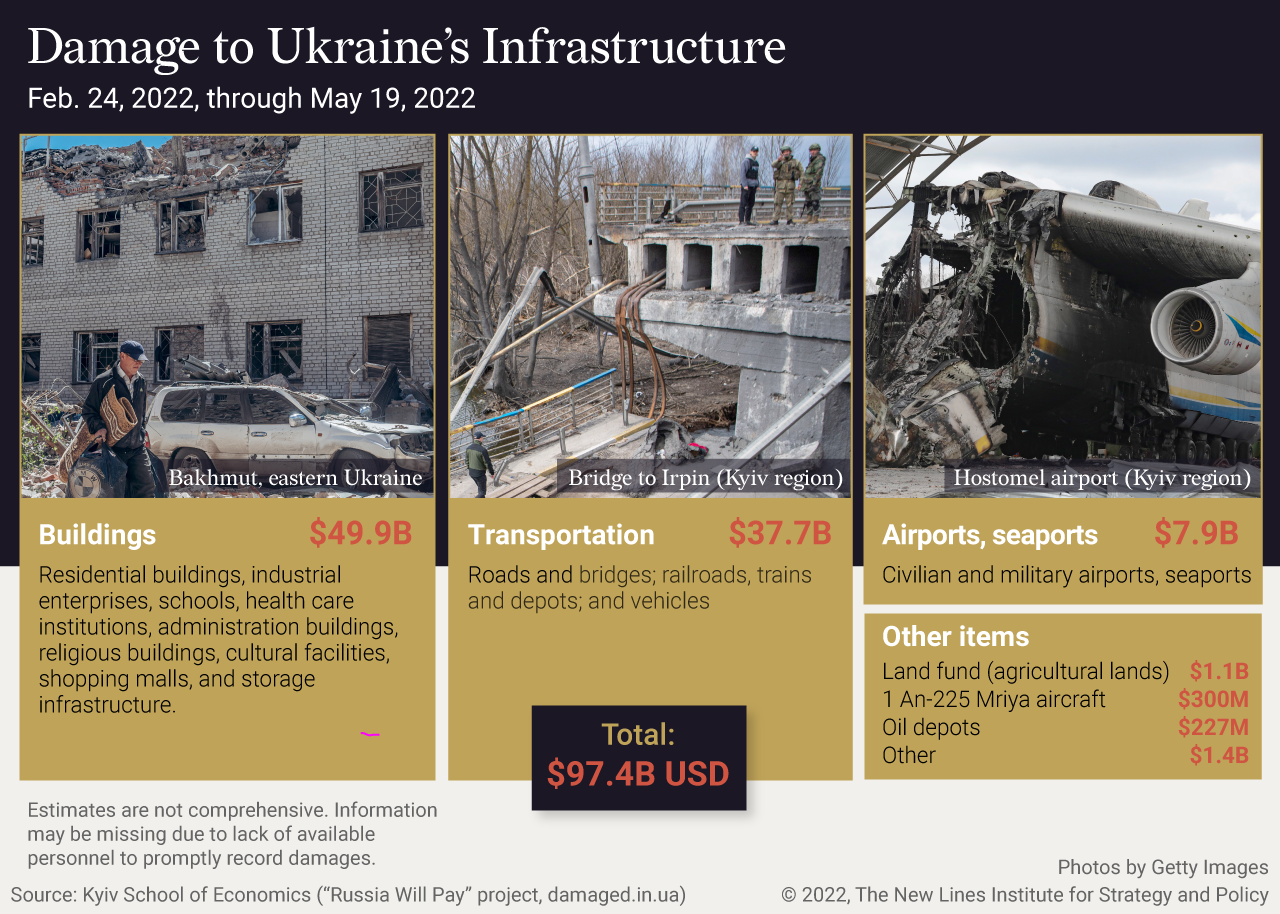
Russian forces mounted an intense bombardment of the city, benefiting from their proximity to logistical hubs and supply lines in Crimea and separatist-held areas in the Donbas. In Mariupol, as is true of Kharkiv and dozens of other Ukrainian cities, civilians have been subject to attacks by a range of munitions and weapons systems, designed for use against military targets but wielded by Russia in densely populated areas. This has included the frequent use of internationally prohibited cluster and incendiary munitions, thermobaric bombs, rocket salvos, heavy artillery, and ship-launched missiles.
In addition to attacks by ground and sea, Mariupol was subject to frequent attacks by Russian aircraft. Since Putin’s shift to the east, the number of air attacks has increased by 150%, with Russian aircrafts regularly carrying out upward of 200 sorties a day against cities in the southeast. On March 16, Russian aircraft destroyed a Mariupol theater in which thousands of civilians were sheltering – a building clearly marked with the word “children” – and killed some 600 people. Intelligence suggests that a precision munition was used to destroy the theater, likely an air dropped 500kg laser-guided bomb.
The destruction wrought in Mariupol serves a further purpose. Russia’s urbicide, in full view of the international community, should be seen as performative violence, intended to send a clear message to Ukraine and its international partners. Mariupol is a warning that can be weaponized by Russia in future coercive negotiations.
Urbicide in Russian Military Doctrine
Russian military operations have long been defined by deliberate destruction of civilian infrastructure. Though virtually all belligerents in modern conflict are responsible for unacceptable levels of civilian harm, particularly in urban contexts, no other state since the allied bombing campaigns of WWII has so consistently and systematically pursued urbicide as a central component of its military operations.
The invasion of Afghanistan in 1979 saw Soviet strategists – battling a skilled and determined insurgency – develop a counter-insurgency strategy based around the encirclement and destruction of entire population centers. It was a strategy that played to Moscow’s technological superiority and overwhelming strength in firepower. In 1983, during an intense two-week campaign of aerial and artillery bombardment, the city of Herat, with a population of 160,000 at the time, was all but flattened. Two-thirds of buildings were destroyed, an estimated 3,000-7,000 civilians killed. Over 1 million Afghan civilians were killed during the Soviet occupation from 1979 to 1989.
The Soviet Union not only relied upon urbicide in its own counter-insurgency campaigns but also exported the doctrine to allies. In Syria, then-President Hafez al-Assad’s military was Soviet equipped and trained. In 1982, following a Muslim Brotherhood uprising, the Assad regime besieged the city of Hama, with the president’s brother, Rifaat al-Assad, leading the assault. Like many Syrian officers, he had been trained at Yekaterinburg Artillery Academy, east of the Urals. The urbicidal massacre that followed in Hama reflected the influence of Soviet counter-insurgency tactics on Rifaat and the Syrian military more broadly. A month of intense and indiscriminate bombardment was followed by street-by-street clearances and bulldozers. The old city was leveled and as many as 40,000 civilians were killed.
Following the collapse of the Soviet Union, these same tactics of urbicide have continued to play a central role in the Kremlin’s military doctrine, a defining feature of the Russian way of war. During the Chechen wars, and then on an unprecedented scale in Syria, the systematic destruction of civilian infrastructure, and even entire cities, has been pursued as a primary objective.
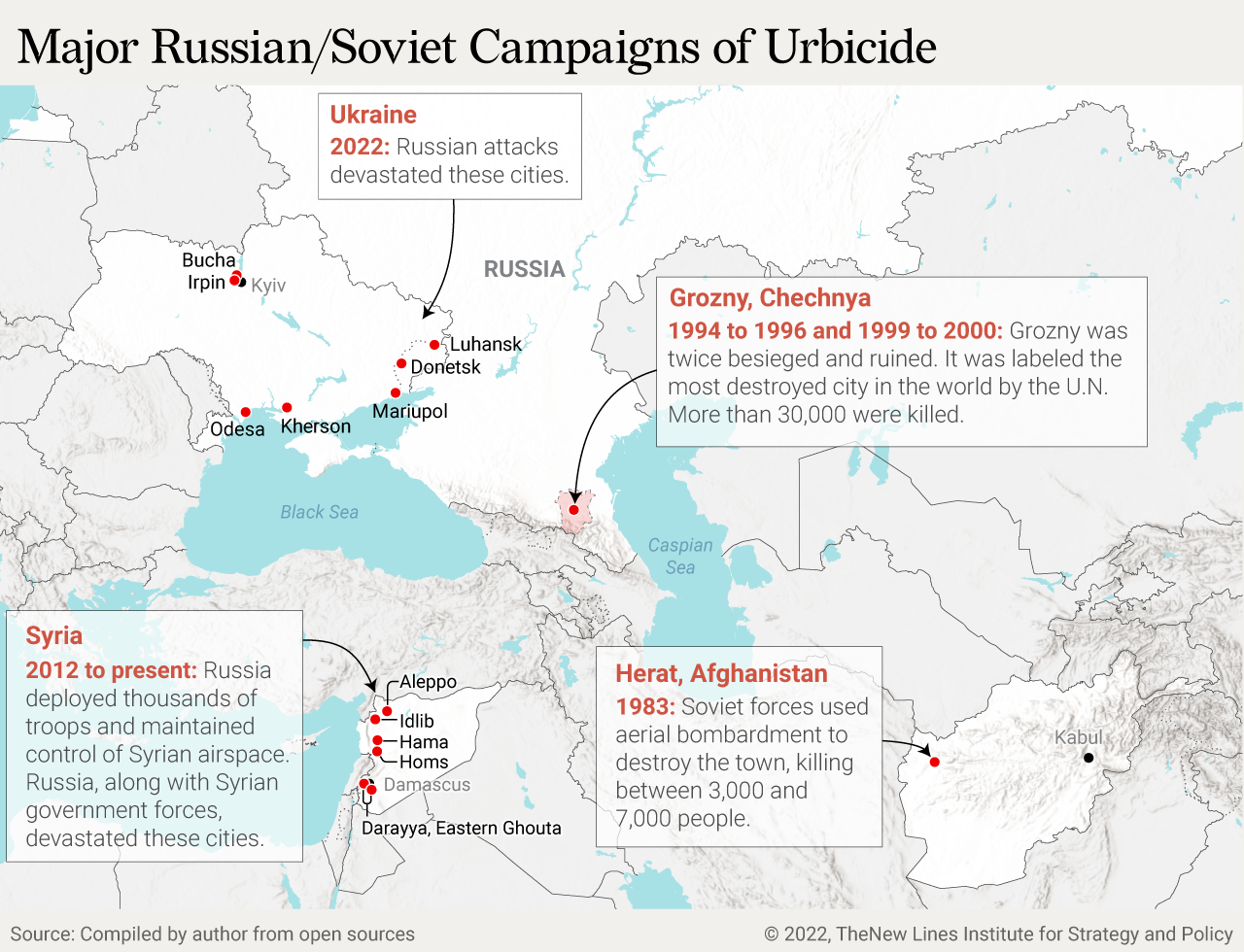
Russian Urbicide in Syria
It has been Syria’s 11-year-long civil war where Putin’s military has, to the most devastating extent, demonstrated its tactics of urbicide. Many of the same Russian pilots, personnel, and strategists that today terrorize Ukraine have done so before in Syria. Since intervening in Syria in September 2015, the Russian military has orchestrated a systematic and ultimately successful campaign of urbicidal siege warfare that has been instrumental in the survival of President Bashar al-Assad’s regime. Russian artillery and airpower, and a parallel surge in Iranian-backed ground forces, catalyzed the slow collapse of Syria’s besieged enclaves, the last long-term urban sieges ending in mid-2018.
Siege Watch estimates that more than 2.5 million Syrians – 10% of the country’s pre-war population – lived under long-term sieges perpetrated by the Assad regime, Russia, and Iran. Syria’s cities were destroyed by the most intense and sustained bombardment of urban population centers since WWII. As is today true in Ukraine, clear patterns of urbicide were evident in Russia’s Syrian operations from the onset. Operating virtually unopposed in Syrian airspace, Russian airpower relentlessly targeted civilians and civilian infrastructure, maximizing the suffering of besieged populations by rendering entire cities uninhabitable. During the first year of Russian airstrikes alone, Airwars documented more than 3,000 civilian casualties. Hospitals, schools, bakeries, markets, and residential neighborhoods in densely populated settlements were systematically destroyed. The Syrian Archive verified more than 45 Russian airstrikes on civilian targets per week throughout the first full year of Moscow’s intervention. During negotiations with opposition enclaves, besieged communities were explicitly threatened: “You will be the next Daraa, the next Aleppo.”
In an estimated 95% of airstrikes in Syria, Russia utilized dumb or unguided munitions, further evidence of the Kremlin’s rejection of International Humanitarian Law. In Ukraine, reports suggest that Russian forces – having exhausted much of their precision-guided weaponry – are increasingly relying on unguided munitions, entirely indiscriminate and hugely destructive when used in populated urban environments.
Syria’s long urbicidal sieges were ended by a series of brutal final offensives, orchestrated by Russian strategists and spearheaded by Russian airpower. Beginning in 2016, Daraa and the suburbs of Western Ghouta, Aleppo, Homs, Hamah, and numerous opposition enclaves were successively forced into surrender by months of tightened blockade and incessant bombardment. The city of Douma, home in 2010 to 600,000, was one of the last major urban enclaves to surrender, encircled as part of the broader siege of Eastern Ghouta. When the city finally surrendered in April 2018, its civilian inhabitants had been subjected to the longest siege in modern history, almost five full years.
The final two-month offensive to retake Douma and Eastern Ghouta, Operation “Damascus Steel,” saw Russian tactics of urbicide escalated to unprecedented levels. Between Feb. 18 and April 8, 2018, the besieged enclave was struck an estimated 16,934 times by airstrike and artillery, 45% of these (including the most destructive attacks) carried out by Russian forces. At levels yet unseen in Ukraine, Russia systematically targeted Douma’s densely populated districts with internationally prohibited cluster and incendiary munitions. In one such attack, early on the morning of March 23, 2018, Russian Su-34 jets pounded Douma’s southern neighborhoods, where tens of thousands of civilians sheltered. The Saraya district burned, struck at least 22 times by Russian incendiary weapons. At least 45 civilians were killed, and many hundreds more were left with horrific burn wounds, entirely untreatable in the besieged city.
The use of such deliberately pernicious weapons points to the cruel logic behind urbicide, to catalyze terror, suffering, and chaos amongst civilian populations, and ultimately to force those labelled as “enemies” into submission. Indeed, on April 7, 2018, it was a chemical weapons attack by the Syrian regime that resulted in the final surrender of Douma, almost half-a-decade of urbicidal siege. Between 15,000 and 20,000 civilians died during the siege, some succumbing to starvation and disease, but most were killed by massive, indiscriminate bombardment.
Urbicide as Demographic Engineering
In Douma, as was the case throughout Syria’s besieged enclaves, the city’s surrender was followed by a campaign of forced displacement – an action prohibited by the 1949 Geneva Conventions. Just as Russia was instrumental in the physical destruction of Douma, it also supervised the forcible transfer of the city’s desperate civilian population. Russian MPs were the first to enter the ruined city and oversaw the convoys that brought more than 90,000 from Eastern Ghouta to Idlib and Aleppo provinces.
Forced population transfers from Douma were part of a broader campaign of demographic engineering throughout Syria. Siege Watch estimates a minimum of 200,000 Syrians from the country’s shattered urban centers were forcibly transferred between 2015 and 2018. This figure does not include forcible population transfer prior to 2015, nor the many millions more who fled urbicidal offensives on foot. In total, more than 13 million Syrians have been forcibly displaced since 2011. Urbicide enabled al-Assad’s violent project of demographic engineering, the destruction of cities, and forced displacement of entire populations ensuring that the demographic population balance of pre-revolution Syria – so nearly fatal to the Assad dynasty – cannot be recreated.
In the context of Russia’s onslaught in Ukraine, the clear link between urbicide and broader projects of authoritarian demographic engineering is one that policy makers must recognize. There are credible reports of tens of thousands of civilians in the east of Ukraine being forcibly transferred to Russia, taken to so-called “filtration camps,” interrogated, and then transferred further east. Evidence suggests that, as was true in Syria, urbicide is enabling a pre-planned and systematic project of demographic engineering in eastern Ukraine through forced population transfers.
Policy Responses
The international community’s response to urbicide in Syria was defined by catastrophic paralysis and the failure to protect Syria’s cities and civilians. Despite unprecedented evidence of war crimes and crimes against humanity, policymakers failed to take concrete measures towards civilian protection. Sanctions packages did little to stop the systematic destruction of Syria’s cities, international humanitarian law and U.N. resolutions were repeatedly flaunted with impunity, and meaningful action on the U.N. Security Council was consistently vetoed by Russia and China. Efforts to ensure humanitarian aid and access, occasionally successful, were never close to meeting the needs of Syria’s besieged and displaced populations.
In Ukraine, the international community must learn from its failed response to systematic devastation in Syria. The U.S. has positioned itself as a clear leader within the global response to war in Ukraine, the single largest contributor in terms of both humanitarian and lethal aid. However, Ukraine’s needs remain dire and urgent. U.N. agencies and international aid organizations warn that the scale of destruction and displacement in Ukraine, particularly in the east, risks outpacing the current humanitarian response.
Policymakers in Washington must ensure that the U.S. continues to lead support for Ukraine, working to maintain political will and emphasizing the principle of collective responsibility that was so often absent in the international community’s response to the violence in Syria. Russia’s urbicide in Ukraine raises several clear areas of focus for policymakers. Most urgently, supporting the ongoing defense of Ukraine’s cities and civilian infrastructure remains a top priority, as does ensuring humanitarian aid and access, and committing to international efforts for justice and accountability.
Lethal Aid
The fastest way to end Russia’s campaign of systematic urbicide in Ukraine is to ensure that the country’s military is properly armed. To stop long-range attacks by air, ground, and sea, and to repel renewed offensives in the Donbas, Ukraine must be provided with a steady flow of weaponry and equipment, ranging from small arms and ammunitions of all types to battle tanks and attack aircraft.
With regards to civilian protection and the immediate defense of critical national infrastructure against long range attacks, efforts to supply more sophisticated weaponry, namely medium-range air defense systems, counter-battery radar, anti-ship missiles, heavy artillery, and loitering munitions, must be expedited. A growing number of these heavier and more sophisticated systems, some of which require training, are now in Ukraine being deployed by Ukrainian forces. However, Zelenskyy has stressed that any interruption in the flow of lethal aid will result in further civilian casualties and even greater destruction.
The U.S., the single largest donor of military funding and aid, has led efforts to arm Ukraine since the onset of the conflict. With much of the initial funding exhausted, Congress’ recent confirmation of a nearly $40 billion military and humanitarian aid package represents a significant and needed escalation in support. The bill includes a $6 billion increase in presidential drawdown authority funding, allowing the Biden administration to send military equipment and weaponry from U.S. stocks. In addition, the package includes a further $6 billion in Ukraine Security Assistance Initiative Funding, allowing weapons to be bought from contractors and provided to Ukraine.
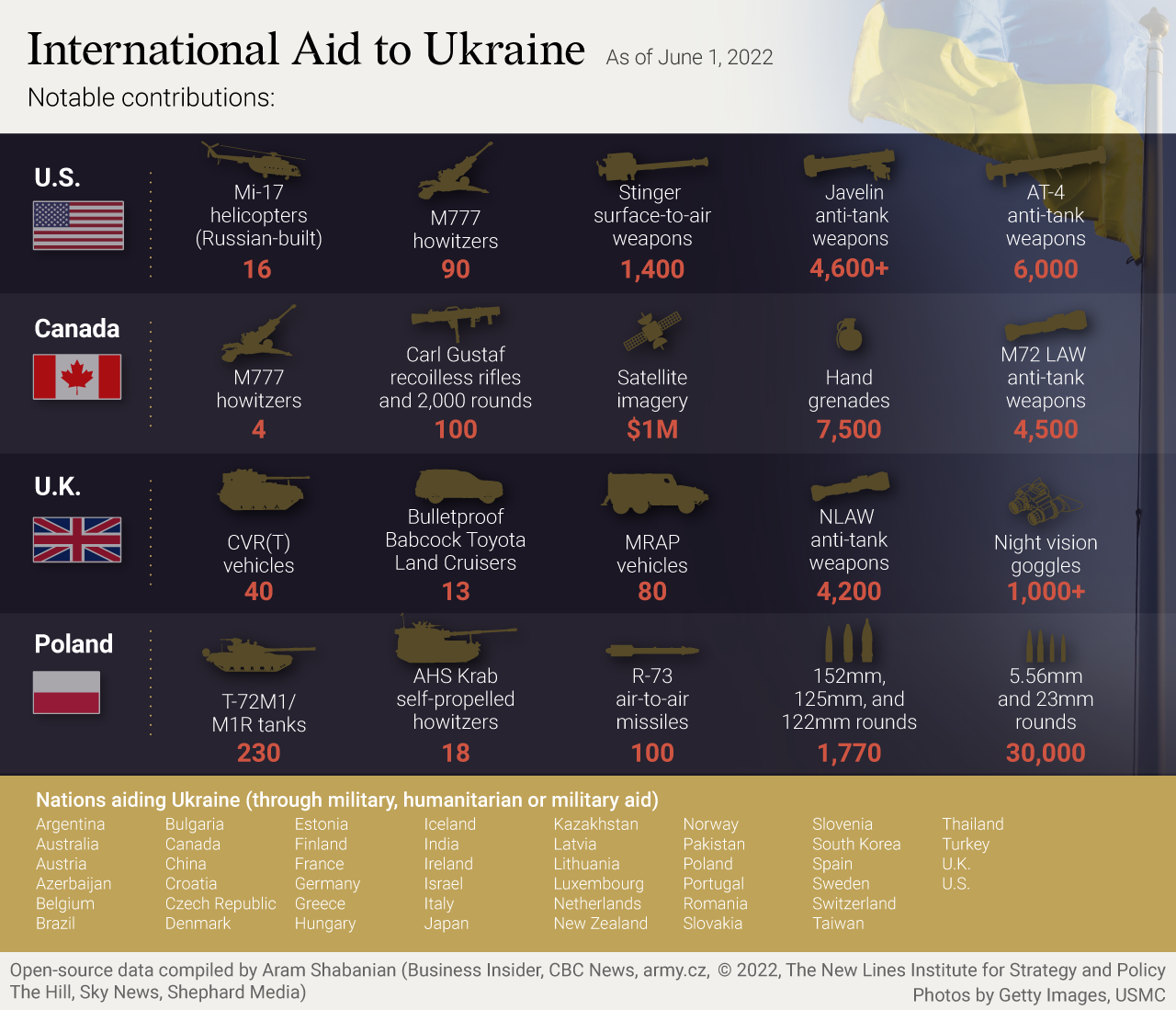
Congress’ relatively swift approval of the package was a display of bipartisan solidarity. The urgent priority must now be to ensure that weapons and equipment are delivered as quickly as possible, cutting down approval and delivery processes and ensuring the rapid provision of necessary training to Ukrainian forces. Looking forward, policymakers must work to maintain the sustained political will necessary for supporting Ukraine through what will likely be a prolonged conflict.
Humanitarian Aid and Access
Urbicide in Ukraine has triggered a massive humanitarian crisis in the country and the broader region. More than 12 million Ukrainians have been displaced in under three months, a figure already approaching the number of Syrians displaced by more than a decade of conflict. More than 15.7 million Ukrainians remain in need of humanitarian aid, protection, and evacuation.
As is true of military aid, the U.S. is the single largest donor of humanitarian aid and funding to Ukraine. The recently passed $40 billion package for Ukraine includes an additional $3 billion in humanitarian assistance, as well as $8.5 billion in economic assistance. With Ukraine’s needs remaining dire, these funds will save lives. However the U.S. role in addressing the Ukrainian refugee crisis must go beyond financing aid efforts. The Biden administration should seek to act as a force multiplier, using its strong ties with allies, international partners, and multilateral institutions to influence a coordinated and long-term European response to the crisis in Ukraine.
It is crucial that U.S. policymakers continue to actively engage and support U.N. agencies, humanitarian organizations, and international NGOs. These neutral actors are on the front line of the humanitarian response. This means urgently mobilizing to fully fund humanitarian appeals, the most recent of which – led by U.N. humanitarian agencies – is requesting an additional $2.25 billion to provide assistance and protection to more than nine million Ukrainians. The appeal has so far been 60% funded, with the U.S. the largest contributor as of May 19.
With regard to Russia’s ongoing tactics of urbicide, ensuring humanitarian access and evacuation must be prioritized. Recent convoys evacuating civilians from the Azovstal Steel Plant, led by the International Committee of the Red Cross (ICRC), was proof that through tireless diplomatic negotiations, civilians can be evacuated safely. All efforts should be made to support organizations like the ICRC in ensuring humanitarian access to those in need.
Justice and Accountability
Putin’s illegal war of aggression has catalyzed extraordinary global support for ensuring that justice and accountability are sought for the war crimes and crimes against humanity perpetrated in Ukraine. The message is clear: Those responsible for the growing litany of violations, from the wanton destruction of the built environment to rape and gender-based violence, will not go unpunished. On May 17, the first Russian soldier to be tried for war crimes in Ukraine since the start of the war, accused of shooting an unarmed pensioner, pleaded guilty before a Kyiv courtroom.
The State Department’s May 25 announcement of the creation of an Atrocity Crimes Advisory Group for Ukraine represents an important step in ensuring those investigating war crimes in Ukraine receive ongoing support. The mechanism, a collaboration between the U.S., EU, and U.K., will seek to promote best practices and expedite the deployment of resources and personnel in order to respond to the needs of the prosecutor general of Ukraine.
The urgent priority at this stage, with violations ongoing, should be ensuring that war crimes investigators are able, where possible, to gain fast and secure access to sites of perpetration. Accurate and timely documentation is key to future prosecutions and policy makers must actively support these efforts. The U.S. State Department’s May 17 announcement of a Conflict Observatory program is encouraging in this regard, with an initial $6 million investment earmarked to analyze, preserve, and share open-source information for future accountability mechanisms.
Given the sheer quantity of evidence and the wide range of actors engaged in collecting it, creativity and the coordination of international efforts will be central to delivering justice. Heeding recent suggestions by Lanny Breuer, former U.S. assistant attorney general, the Biden administration should take the lead and arrange meetings for international actors to coordinate and explore possible pathways towards accountability.
Since the earliest weeks of Russia’s invasion, the State Department has funded independent experts who provide support to Ukrainian investigators. Continued partnership and cooperation will be vital in ensuring the evidentiary basis necessary for future prosecutions, whether that be in Ukraine’s own courts, in individual states under universal jurisdiction, or the International Criminal Court. U.S. policymakers should announce their intention to send war crimes prosecutors to that court or any special tribunal established in response to the conflict.
Restricting the Use of Explosive Weapons in Populated Areas
Though not so immediately relevant to Ukraine’s urgent needs, Russia’s onslaught has brought international efforts to reduce the use of Explosive Weapons in Populated Areas (EWIPA) into sharp focus. Urban devastation and massive civilian harm have become a defining feature of contemporary conflict, and Russia’s urbicide in Ukraine has emphasized the continued urgency of tackling this destructive trend.
Notably, civil society organizations and 65 states (including the U.S., U.K., Canada, and Israel) recently met in Geneva to work toward a political declaration that would restrict the use of EWIPA. The U.S., U.K. and Israel have previously argued that the proposed declaration would be too restrictive for militarily active states, but recent meetings saw a shift in the collective tone. Though differences remain, several states, not least the U.S., demonstrated a commitment to strengthening the protection of civilians through the declaration.
Policymakers should proactively advocate for the successful conclusion of the EWIPA negotiations. This would send the message that the U.S. is actively seeking to reaffirm the humanitarian norms that have been so damaged by conflicts like Ukraine and Syria. In addition, it would represent concrete progress toward addressing the levels of civilian harm resulting from U.S. military operations in urban areas such as Mosul and Raqqa.
Aaron Clements-Hunt is a writer and researcher with a focus on violence against civilians in contemporary conflict. He has an MA in Holocaust & Genocide Studies from the University of Amsterdam. Much of his research has focused on the Syrian conflict and, in particular, the Assad regime’s campaign of urbicidal siege warfare. You can follow him on Twitter @AaronClementsHu.
The views expressed in this article are those of the author and not an official policy or position of the New Lines Institute.

